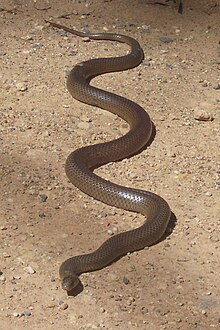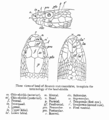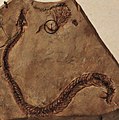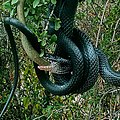Portal:Snakes
The Snake PortalSnakes are elongated, limbless, carnivorous reptiles of the suborder Serpentes (/sɜːrˈpɛntiːz/). Like all other squamates, snakes are ectothermic, amniote vertebrates covered in overlapping scales. Many species of snakes have skulls with several more joints than their lizard ancestors, enabling them to swallow prey much larger than their heads (cranial kinesis). To accommodate their narrow bodies, snakes' paired organs (such as kidneys) appear one in front of the other instead of side by side, and most have only one functional lung. Some species retain a pelvic girdle with a pair of vestigial claws on either side of the cloaca. Lizards have independently evolved elongate bodies without limbs or with greatly reduced limbs at least twenty-five times via convergent evolution, leading to many lineages of legless lizards. These resemble snakes, but several common groups of legless lizards have eyelids and external ears, which snakes lack, although this rule is not universal (see Amphisbaenia, Dibamidae, and Pygopodidae). Living snakes are found on every continent except Antarctica, and on most smaller land masses; exceptions include some large islands, such as Ireland, Iceland, Greenland, and the islands of New Zealand, as well as many small islands of the Atlantic and central Pacific oceans. Additionally, sea snakes are widespread throughout the Indian and Pacific oceans. Around thirty families are currently recognized, comprising about 520 genera and about 3,900 species. They range in size from the tiny, 10.4 cm-long (4.1 in) Barbados threadsnake to the reticulated python of 6.95 meters (22.8 ft) in length. The fossil species Titanoboa cerrejonensis was 12.8 meters (42 ft) long. Snakes are thought to have evolved from either burrowing or aquatic lizards, perhaps during the Jurassic period, with the earliest known fossils dating to between 143 and 167 Ma ago. The diversity of modern snakes appeared during the Paleocene epoch (c. 66 to 56 Ma ago, after the Cretaceous–Paleogene extinction event). The oldest preserved descriptions of snakes can be found in the Brooklyn Papyrus. (Full article...) Selected article -The eastern brown snake (Pseudonaja textilis), often referred to as the common brown snake, is a species of extremely venomous snake in the family Elapidae. The species is native to eastern and central Australia and southern New Guinea. It was first described by André Marie Constant Duméril, Gabriel Bibron, and Auguste Duméril in 1854. The adult eastern brown snake has a slender build and can grow to 2 m (7 ft) in length. The colour of its surface ranges from pale brown to black, while its underside is pale cream-yellow, often with orange or grey splotches. The eastern brown snake is found in most habitats except dense forests, often in farmland and on the outskirts of urban areas, as such places are populated by its main prey, the house mouse. The species is oviparous. The International Union for Conservation of Nature classifies the snake as a least-concern species, though its status in New Guinea is unclear. It is considered the world's second-most venomous land snake after the inland taipan (Oxyuranus microlepidotus), based on its LD50 value (subcutaneous) in mice. The main effects of its venom are on the circulatory system—coagulopathy, haemorrhage (bleeding), cardiovascular collapse, and cardiac arrest. One of the main components of the venom is the prothrombinase complex pseutarin-C, which breaks down prothrombin. (Full article...)Did you know (auto-generated) -
More did you know? -
Quality ContentFeatured snake-related articles - George Went Hensley - List of snakes of Trinidad and Tobago Good snake-related articles - Agkistrodon piscivorus - Bitis arietans - Bitis gabonica - Black mamba - Black-necked spitting cobra - Eastern green mamba - Forest cobra - Hydrophiinae - Many-banded krait - Nerodia clarkii - Russell's viper - Snake scales - Vipera berus - Western green mamba TopicsLists - List of snakes by common name - List of Serpentes families - List of snake genera - List of dangerous snakes
Families - Acrochordidae - Aniliidae - Anomochilidae - Boidae - Bolyeriidae - Colubridae - Cylindrophiidae - Elapidae - Loxocemidae - Pythonidae - Tropidophiidae - Uropeltidae - Viperidae - Xenopeltidae - Anomalepididae - Leptotyphlopidae - Typhlopidae Anatomy and physiology - Infrared sensing in snakes - Pelvic spur - Snake scales - Snake skeleton SubcategoriesRelated portalsNeed help?Do you have a question about Snakes that you can't find the answer to? Consider asking it at the Wikipedia reference desk. Snakes in the newsNo recent news Things you can do
Help at WikiProjects:
Associated WikimediaThe following Wikimedia Foundation sister projects provide more on this subject:
Discover Wikipedia using portals |






























































